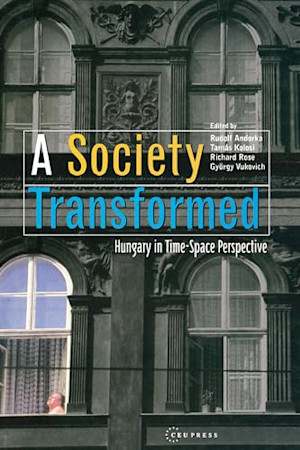
A Society Transformed
Hungary in Time-Space Perspective
In the past half-century every Central and East European society has been twice subject to transformation. Initially, Hungary was transformed by communist-style modernization, increasing industry, expanding secondary education and improving health. The second shock was the collapse of the communist regime and the introduction of democratic institutions and a market economy. How much or how little impact has institutional change had on the lives of ordinary people?
Drawing on detailed surveys, highlighted in tables and figures, the authors identify long-term changes in Hungary from the late 1940s to the late 1980s and provide an in-depth analysis of the impact of the collapse of the communist system in the 1990s. They also compare long-term and shor-term change in Hungary with trends in other Central and Eastern European countries.
+
Kopen via Taylor & Francis 
CEU Press titels worden gedistribueerd via Taylor & Francis
Redacteuren
Rudolf Andorka
Rudolf Andorka was Professor of Sociology and former Rector of the Budapest University of Economics.
György Vukovich
György Vukovich is former Director of the Hungarian Central Statistical Office.
Tamás Kolosi
Tamás Kolosi is President of the Social Research Informatics Centre, Budapest.
- Titel
- A Society Transformed
- Subtitel
- Hungary in Time-Space Perspective
- Redacteuren
- Richard Rose
- Rudolf Andorka
- György Vukovich
- Tamás Kolosi
- Prijs
- € 122,00 excl. BTW
- ISBN
- 9789639116498
- Uitvoering
- Hardback
- Aantal pagina's
- 224
- Taal
- Engels
- Publicatiedatum
- 06 - 01 - 1999
- Afmetingen
- 15.9 x 23.4 cm
- Categorie
- Sociology and Social History
- Discipline
- Social and Political Sciences
- Imprint
- CEU Press

- Ook beschikbaar als
- eBook PDF - € 130,00
Contents
Introduction
Chapter 1: Long-term modernization of Hungarian society
Chapter 2: Population: birth, marriage and death
Chapter 3: Denomination and religious practice
Chapter 4: The scope of the state and private sectors
Chapter 5: The post-communist economic elite
Chapter 6: Middle strata in transformation
Chapter 7: Consciousness of inequality
Chapter 8: Welfare programs and the alleviation of poverty
Chapter 9: Dissatisfaction and alienation
Chapter 10: Parties and social divisions
Chapter 11: The long and short of transformation in Central Europe





